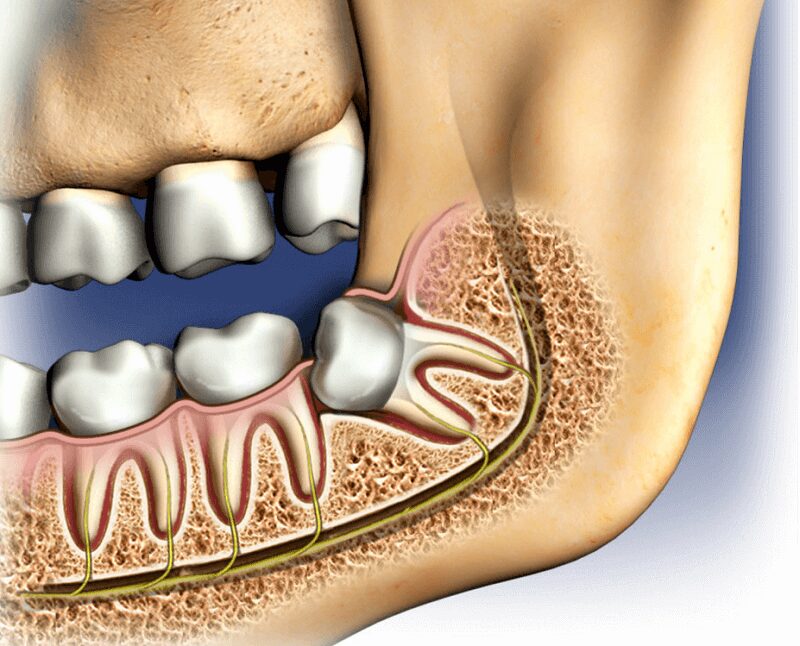Wisdom Tooth Problems
Why do dentists remove wisdom teeth?
Dentists often recommend removing wisdom teeth, also known as third molars, for several reasons:
- Impaction: Wisdom teeth are the last teeth to erupt, and there is often limited space in the mouth for them to come in properly. As a result, wisdom teeth may become impacted, meaning they are unable to fully emerge through the gums. Impacted wisdom teeth can lead to pain, infection, and damage to surrounding teeth.
- Crowding: Even if wisdom teeth are able to partially erupt, they can cause crowding and misalignment of the other teeth. This can affect the bite and make it difficult to properly clean the teeth, increasing the risk of tooth decay and gum disease.
- Infection: Wisdom teeth that are partially erupted can create a flap of gum tissue that traps food particles and bacteria, leading to an increased risk of infection in the area.
- Cysts and tumors: In rare cases, cysts or tumors may form around impacted wisdom teeth, which can cause damage to the jawbone and surrounding teeth.
- Dental issues: Wisdom teeth are located at the back of the mouth, making them difficult to clean properly. This can increase the risk of cavities and gum disease.
- Orthodontic reasons: In some cases, the presence of wisdom teeth can interfere with orthodontic treatment, especially if there is limited space in the mouth.
Overall, the decision to remove wisdom teeth is based on the individual’s oral health, the position of the teeth, and the presence of symptoms or complications. Dentists may recommend removing wisdom teeth preventively, even if they are not causing immediate problems, to prevent potential issues in the future.
What is involved in wisdom teeth removal?
Wisdom teeth removal, also known as extraction, is a common dental procedure that is typically performed by an oral surgeon or a dentist. The procedure can be done under local anesthesia, sedation, or general anesthesia, depending on the complexity of the extraction and the patient’s preference.
Here is an overview of what is involved in wisdom teeth removal:
- Preparation: Before the procedure, the oral surgeon or dentist will review the patient’s medical history and may take X-rays to evaluate the position of the wisdom teeth and their relationship to nearby structures, such as nerves and sinuses. The patient will also be informed about what to expect during and after the procedure.
- Anesthesia: The patient will receive anesthesia to numb the area around the tooth or to induce sedation or general anesthesia. The type of anesthesia used will depend on the complexity of the extraction and the patient’s comfort level.
- Extraction: The oral surgeon or dentist will then remove the wisdom teeth. If the teeth are impacted, meaning they are trapped beneath the gum line or in the jawbone, the surgeon may need to make an incision in the gum and remove bone to access the teeth. The teeth may be removed in pieces to make the extraction easier.
- Closure: After the teeth are removed, the surgeon will clean the extraction site and may place stitches to close the gum tissue. In some cases, the extraction site may be packed with gauze to help control bleeding and promote healing.
- Recovery: After the procedure, the patient will be monitored in the recovery area until the effects of the anesthesia wear off. It is normal to experience some pain, swelling, and bleeding after wisdom teeth removal. The patient will be given instructions on how to care for the extraction site and manage any discomfort.
- Follow-up: The patient may need to schedule a follow-up appointment to ensure that the extraction site is healing properly and to remove any stitches, if necessary.
Wisdom teeth removal is generally a safe and effective procedure, but like any surgery, it carries some risks, such as infection, nerve damage, and dry socket (when the blood clot in the extraction site is dislodged). It is important for patients to follow their dentist’s or oral surgeon’s instructions for aftercare to minimize the risk of complications and promote healing.




